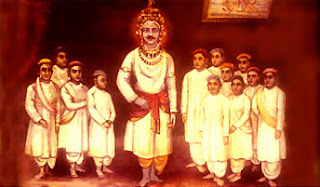Kayasthas practice family exogamy and caste endogamy preferring to marry only within their sub-castes. The individuals of same Al can not intermarry, while those of same caste and different Als can. Thus an individual from Srivastava subcaste and Pandey Al should not marry another Pandey of the same subcaste but can marry an individual belonging to another al of the same subcaste. Though not required, it is still widely practiced as a tradition.
Worship
Kayasthas worship ShreeChitraguptaji and on Bhai-Dooj, they celebrate Kalam-Dawaat Pooja (pen, ink-pot and sword worship), a ritual in which pens, papers and books are worshipped. This is the day when Shree Chitraguptji was created by Lord Bramha and Yamaraj got relieved of His duties and used this leave to visit His sister Devi Yamuna; hence the whole world celebrates Bhaiya dooj on this day and the Kayastha celebrate ShreeChitraguptajayanti, i.e. the ‘Birthday’ of their progenitor.
By worshipping Chitragupta who is their ancestor, kayasthas have the singular distinction of being the only “Ancestor-worshipping” sect of Hinduism.
Food
Unlike most Baniya (Vaishya) or Brahmins, and like Kshatriyas, Kayasthas eat onions, garlic, meats like mutton and chicken, fish and eggs, though a large number are also vegetarians. Meat eating kayasthas do avoid beef as the cow is considered sacred for Hindus.
It is believed though not yet proved that Kayasthas of holy towns like Prayag, Mathura, Varanasi, etc. are purely vegetarians, while in other areas they may be mixed. It is said that Kayasthas started eating meat during the Muslim period when they socially mixed with the Muslims. It is also said that Kayasthas have the best eating sense, because amongst Hindus, Kayasthas add the largest varieties of food to their diet.
Social
Of all the other castes in India, Kayasthas are the easiest to mingle with other castes. They did this when the Muslims came to India, and modern examples of this are Kayasthas outside India where they mingle with other castes more than they mingle among themselves. This cosmopolitan outlook distinguishes members of this caste, and along with the great emphasis on education, is to a large extent responsible for their success in changing times.

